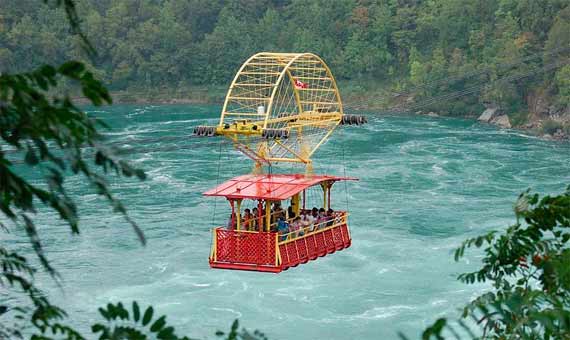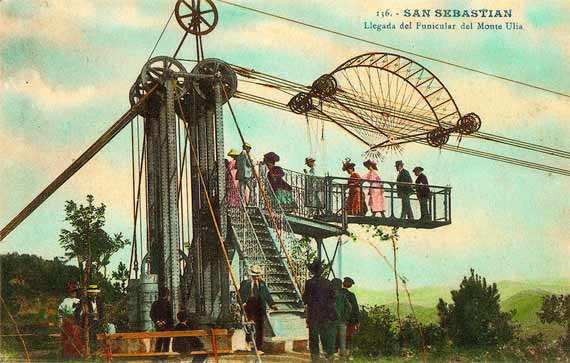Coinciding with the centenary of the Spanish Aerocar, in 2016 we celebrate the Torres Quevedo Year. This Spanish engineer, who has been defined as “the most magnificent inventor of his time”, has an exceptional place in the universal history of science and technology, with numerous inventions and patents that were ahead of their time in areas such as computer science or artificial intelligence.
August 8, 1916 saw the inauguration in Niagara (Canada) of the first aerial tramway in North America, the Niagara Spanish Aerocar. It had been built by a Spanish company, The Niagara Spanish Aerocar Company, incorporated in Canada with Spanish capital, Spanish management, a Spanish construction engineer, material transported from Spain to Canada during the First World War, initially operated commercially by Spaniards… It was based on the project of an engineer from Santander, Leonardo Torres Quevedo (Santa Cruz de Iguña, 1852 – Madrid, 1936). In 1930, Maurice d’Ocagne, the president of the French Mathematical Society, defined him as “the most magnificent inventor of his time”.

The Spanish Aerocar was the culmination of an invention conceived in Valle de Iguña (Cantabria) 130 years ago, first near his residence in Portolín (Molledo) and later over the River León. The technological innovation was patented in 1887 in Valle de Iguña and extended to Germany, Switzerland, France, the United Kingdom, Canada, Austria, Spain, Italy and the United States. Its inventor named it an aerocar and it constitutes a genuinely Spanish contribution to world engineering.
Leonardo Torres Quevedo has an exceptional place in the universal history of science and technology
The Spanish Aerocar was actually a model evolved from the first aerial tramway open to the public in the world, also a work by Torres Quevedo: the Monte Ulía aerial tramway (San Sebastián), inaugurated in 1907, thirty years after submitting the patent for his system. It had been funded and built by another Spanish company, Sociedad de Estudios y Obras de Ingeniería, incorporated in 1906 following the success of the tests conducted with the Telekino (the first remote control in history, also an invention by Torres Quevedo).

This company -whose shareholders included the most select representation of businesspeople, industrialists and bankers from the Basque Country (and some from Santander) of the time- had been set up with one goal: “to experimentally study the projects submitted by Leonardo Torres Quevedo and implement them when deemed appropriate”. It was a pioneering initiative of what today is known as R&D.
Ahead of his time
The Monte Ulía Aerial Tramway would be followed by others built around the world by other engineers who adapted the ideas of the Spanish inventor: in Switzerland, France, Austria, Germany, Brazil, etc. In fact, all the aerial tramways built in the 20th century, and those that continue to be built in the 21st century in Spain and in other countries, are based on his 1887 patent: a self-balancing system of supporting and traction cables, working at a constant strain determined by the counterweights located at one of its ends.
According to professor Francisco González de Posada (UPM) of the Association of Friends of Scientific Culture, Leonardo Torres Quevedo “has an exceptional place in the universal history of science and technology”.
Between 1901 and 1906 he conceived a system of rigid airships with which he laid the foundations for ballooning. In 1902 he patented in France, Spain, the United Kingdom and the U.S. the first remote control in history, the Telekino, conceived for remotely controlling his airships and a direct forerunner of today’s drones. In 1913 he combined navigation and aeronautics in his patent for the ship-camp, designs that would be used by the Spanish Navy in its first aircraft carrier, the Dédalo.
And very particularly for today’s world, governed by information and communication technologies, we have his most important theoretical work, “Essays on Automatics” (1914), his chess players (1912 and 1922) and his electromechanical arithmometer (1920), that could be considered the first computer in history and which was several decades ahead of the pioneers of computer science, automatics and artificial intelligence of the 20th century.
2016: A year of centenaries
In addition to the centenary of the Niagara Spanish Aerocar, 2016 marks one hundred years since the patent of his twin-ship, a pioneering conception of the metal hulled catamarans used today for express passenger sea transport around the world. It has also been one hundred years since he was awarded the Echegaray Medal of the Royal Academy of Sciences, and above all, the emergence of rigid airships designed by him and operated by the navies of France and the United Kingdom (the next year, also of the United States) during the First World War. These airships proved to be most effective for antisubmarine warfare, convoy protection and coastal surveillance. With new materials, they have continued to be built in the 20th century and even today in countries such as France or Russia.
The Association of Friends of Scientific Culture, the Milvelas Group and the Menéndez Pelayo Royal Society in Santander have understood that in 2016, on the 100th anniversary of operation with no accidents of the Niagara Spanish Aerocar, the world of Spanish university, culture and science should commemorate the centenary of the Niagara Spanish Aerocar, 1916-2016, vindicating the great work of “the most magnificent inventor of his time”: Leonardo Torres Quevedo.
This in an extract of an original article published on the website of Fundación madri+d
Francisco A. González Redondo
Tenured Professor of History of Science in the Algebra Department, School of Education, Universidad Complutense de Madrid
Comments on this publication